light HONDA PRELUDE 1998 Manual PDF
[x] Cancel search | Manufacturer: HONDA, Model Year: 1998, Model line: PRELUDE, Model: HONDA PRELUDE 1998Pages: 278, PDF Size: 2.61 MB
Page 231 of 278

Changing a Flat Tire, If Your Engine Won't Start
19. Secure the flat tire by screwing the win
g bolt back into its hole.
20. Store the jack in its holder. Turn the jack's end bracket to lock it in
place.
Replace the cover. Store the
tool kit. 21. Stor
e the center cap in the trunk.
Make
sure it does not get scratch-
ed
or damaged.
22.
Lower the trunk floor, then close
the trunk lid.
Type SH only
If yo
u mount the compact spare on
either front or rear tire, it may cause
the
ATTS indicator light in the
instrument
panel to come on due to
the
difference in tire diameter. The
light
will go out when the proper tire
is installed.
If Your Engine Won't Start
Diagnosing
why your engine won't
start falls into two areas, depending
on what you hear when you turn the
key to START (III):
You hear nothing, or almostnothing. The engine's starter
motor does not operate at all, oroperates
very slowly. You can hear the starter motor
operating normally, or the starter
motor
sounds like it is spinning
faster than normal, but the engine does
not start up and run.
Taking Car
e of the Unexpected
Loose items can fly around the
interior i
n a crash and could
seriously injure the occupants.
Store th
e wheel, jack and tools
securely before driving.
ProCarManuals.comMain Menu Table of Contents s t
Page 232 of 278
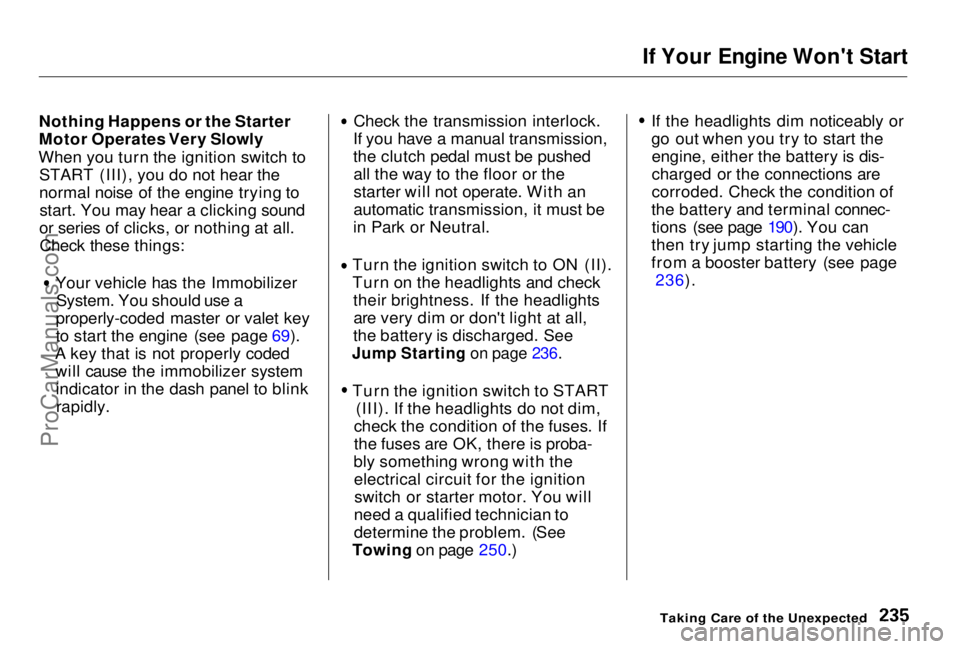
If Your Engine Won't Start
Nothing Happens or the Starter
Motor Operates Very Slowly
When you turn the ignition switch to START (III), you do not hear the
normal noise of the engine trying tostart. You may hear a clicking sound
or series of clicks, or nothing at all. Check these things: Your vehicle has the Immobilizer
System. You should use a
properly-coded master or valet key
to start the engine (see page 69).
A key that is not properly coded will cause the immobilizer systemindicator in the dash panel to blinkrapidly. Check the transmission interlock.
If you have a manual transmission,
the clutch pedal must be pushed all the way to the floor or the
starter will not operate. With an
automatic transmission, it must be
in Park or Neutral. Turn the ignition switch to ON (II).
Turn on the headlights and check
their brightness. If the headlightsare very dim or don't light at all,
the battery is discharged. See
Jump Starting on page 236.
Turn the ignition switch to START
(III). If the headlights do not dim,
check the condition of the fuses. If
the fuses are OK, there is proba-
bly something wrong with the electrical circuit for the ignitionswitch or starter motor. You will
need a qualified technician to
determine the problem. (See
Towing on page 250.) If the headlights dim noticeably or
go out when you try to start the
engine, either the battery is dis-
charged or the connections are
corroded. Check the condition of
the battery and terminal connec- tions (see page 190). You can
then try jump starting the vehicle
from a booster battery (see page
236).
Taking Care of the UnexpectedProCarManuals.comMain Menu Table of Contents s t
Page 233 of 278
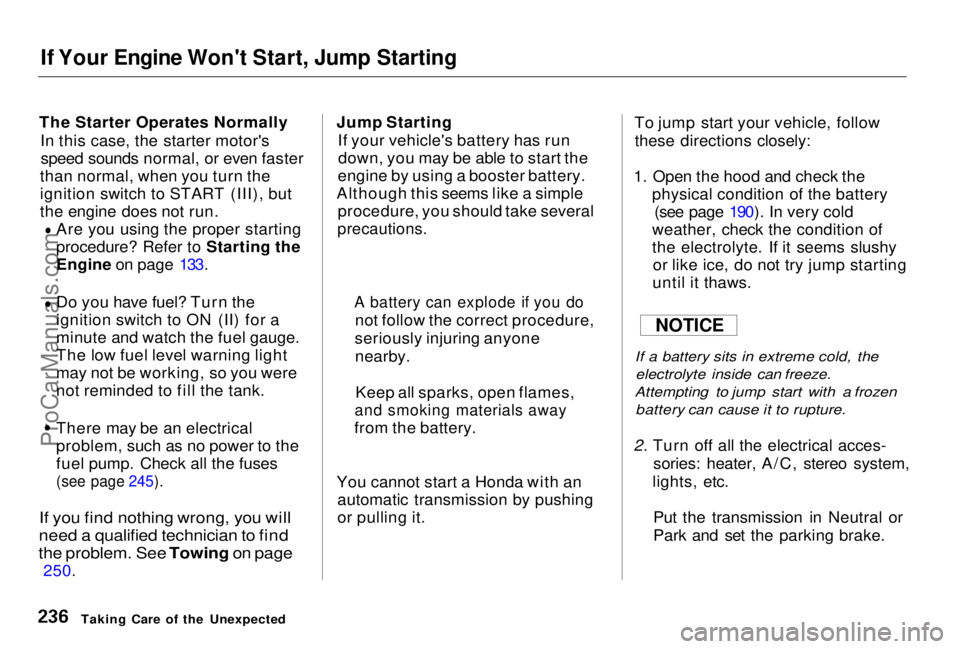
If Your Engine Won't Start, Jump Starting
The Starter Operates Normally In this case, the starter motor'sspeed sounds normal, or even faster
than normal, when you turn the
ignition switch to START (III), but
the engine does not run. Are you using the proper starting
procedure? Refer to Starting the
Engine on page 133.
Do you have fuel? Turn the
ignition switch to ON (II) for a
minute and watch the fuel gauge.
The low fuel level warning light
may not be working, so you were
not reminded to fill the tank.
There may be an electrical
problem, such as no power to the
fuel pump. Check all the fuses
(see page 245).
If you find nothing wrong, you will
need a qualified technician to find
the problem. See Towing on page
250. Jump Starting
If your vehicle's battery has rundown, you may be able to start the
engine by using a booster battery.
Although this seems like a simple procedure, you should take several
precautions.
You cannot start a Honda with an automatic transmission by pushing
or pulling it. To jump start your vehicle, follow
these directions closely:
1. Open the hood and check the physical condition of the battery(see page 190). In very cold
weather, check the condition of
the electrolyte. If it seems slushy or like ice, do not try jump starting
until it thaws.
If a battery sits in extreme cold, the
electrolyte inside can freeze.
Attempting to jump start with a frozen
battery can cause it to rupture.
2. Turn off all the electrical acces- sories: heater, A/C, stereo system,
lights, etc.
Put the transmission in Neutral or
Park and set the parking brake.
Taking Care of the Unexpected
NOTICE
A battery can explode if you do
not follow the correct procedure,
seriously injuring anyone nearby.
Keep all sparks, open flames,
and smoking materials away
from the battery.ProCarManuals.comMain Menu Table of Contents s t
Page 237 of 278
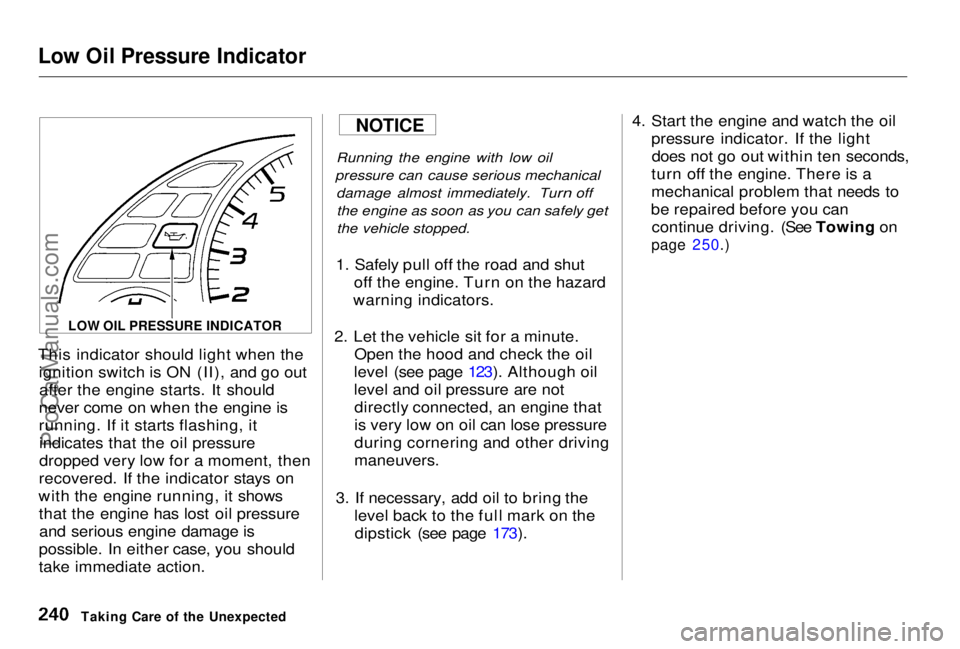
Low Oil Pressure Indicator
This indicator should light when the
ignition switch is ON (II), and go outafter the engine starts. It should
never come on when the engine is
running. If it starts flashing, it indicates that the oil pressure
dropped very low for a moment, then
recovered. If the indicator stays on
with the engine running, it shows that the engine has lost oil pressureand serious engine damage is
possible. In either case, you should
take immediate action.
Running the engine with low oil
pressure can cause serious mechanical damage almost immediately. Turn off
the engine as soon as you can safely get
the vehicle stopped.
1. Safely pull off the road and shut off the engine. Turn on the hazard
warning indicators.
2. Let the vehicle sit for a minute. Open the hood and check the oil
level (see page 123). Although oil
level and oil pressure are not directly connected, an engine that
is very low on oil can lose pressure
during cornering and other driving
maneuvers.
3. If necessary, add oil to bring the level back to the full mark on thedipstick (see page 173). 4. Start the engine and watch the oil
pressure indicator. If the lightdoes not go out within ten seconds,
turn off the engine. There is a
mechanical problem that needs to
be repaired before you can continue driving. (See Towing on
page 250.)
Taking Care of the Unexpected
NOTICE
LOW OIL PRESSURE INDICATOR
ProCarManuals.comMain Menu Table of Contents s t
Page 240 of 278
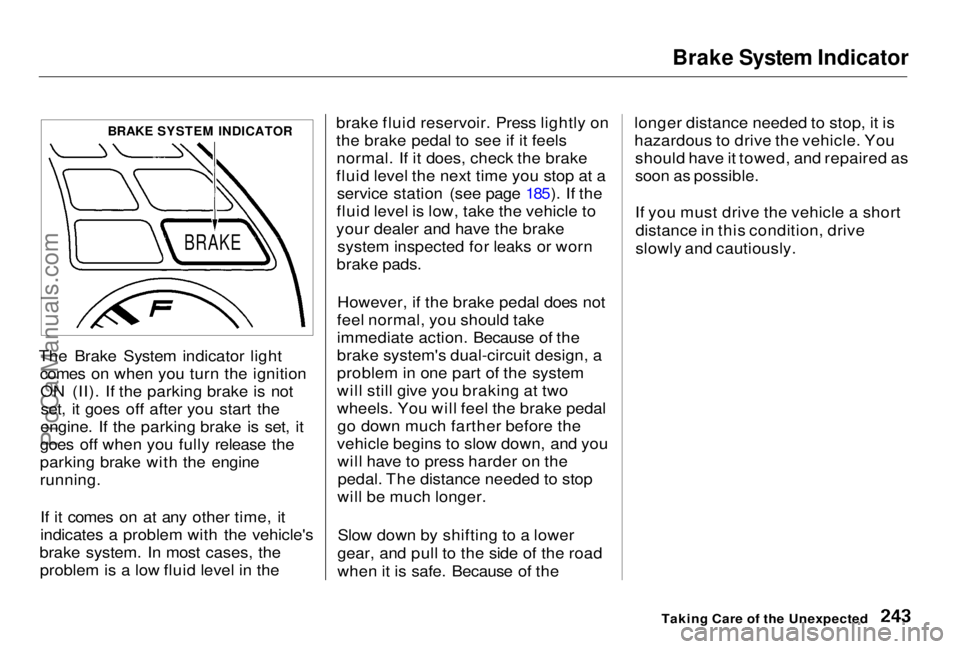
Brake System Indicator
The Brake System indicator light comes on when you turn the ignitionON (II). If the parking brake is notset, it goes off after you start the
engine. If the parking brake is set, it
goes off when you fully release the
parking brake with the engine
running.
If it comes on at any other time, it
indicates a problem with the vehicle's
brake system. In most cases, the problem is a low fluid level in the brake fluid reservoir. Press lightly on
the brake pedal to see if it feels
normal. If it does, check the brake
fluid level the next time you stop at a service station (see page 185). If the
fluid level is low, take the vehicle to
your dealer and have the brake system inspected for leaks or worn
brake pads.
However, if the brake pedal does not
feel normal, you should take
immediate action. Because of the
brake system's dual-circuit design, a
problem in one part of the system
will still give you braking at two
wheels. You will feel the brake pedal go down much farther before the
vehicle begins to slow down, and you will have to press harder on thepedal. The distance needed to stop
will be much longer.
Slow down by shifting to a lower
gear, and pull to the side of the road
when it is safe. Because of the longer distance needed to stop, it is
hazardous to drive the vehicle. You
should have it towed, and repaired as
soon as possible.
If you must drive the vehicle a short
distance in this condition, drive
slowly and cautiously.
Taking Care of the Unexpected
BRAKE SYSTEM INDICATOR
BRAKEProCarManuals.comMain Menu Table of Contents s t
Page 243 of 278
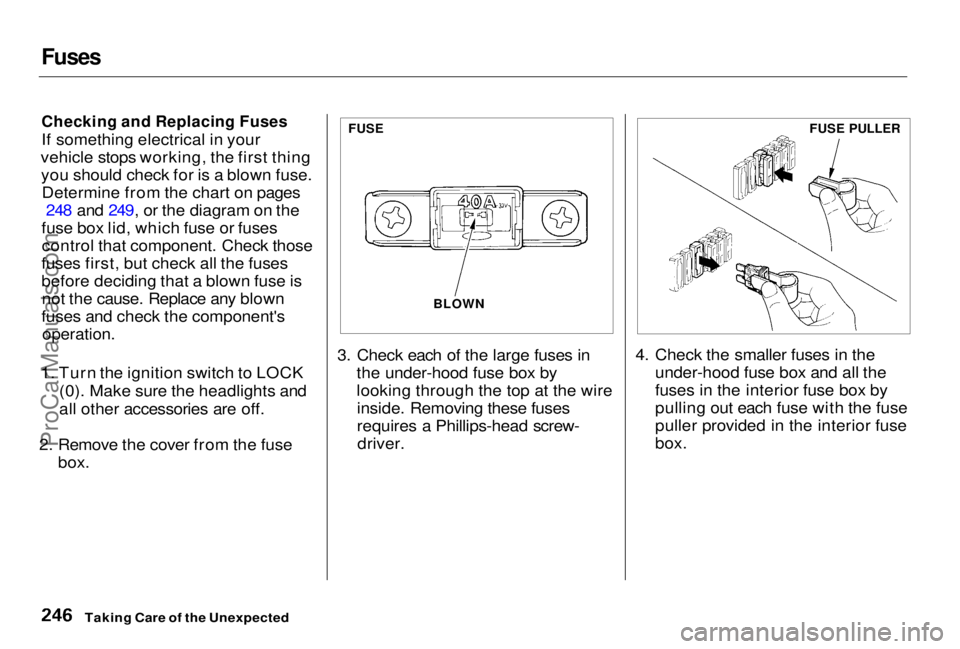
Fuses
Checking and Replacing Fuses
If something electrical in your
vehicle stops working, the first thing you should check for is a blown fuse. Determine from the chart on pages 248 and 249, or the diagram on the
fuse box lid, which fuse or fuses control that component. Check those
fuses first, but check all the fuses
before deciding that a blown fuse is not the cause. Replace any blown
fuses and check the component's
operation.
1. Turn the ignition switch to LOCK (0). Make sure the headlights and
all other accessories are off.
2. Remove the cover from the fuse
box.
3. Check each of the large fuses in
the under-hood fuse box by
looking through the top at the wireinside. Removing these fuses
requires a Phillips-head screw-driver. 4. Check the smaller fuses in the
under-hood fuse box and all the
fuses in the interior fuse box by
pulling out each fuse with the fuse
puller provided in the interior fuse
box.
Taking Care of the Unexpected
FUSE
BLOWN
FUSE PULLERProCarManuals.comMain Menu Table of Contents s t
Page 252 of 278
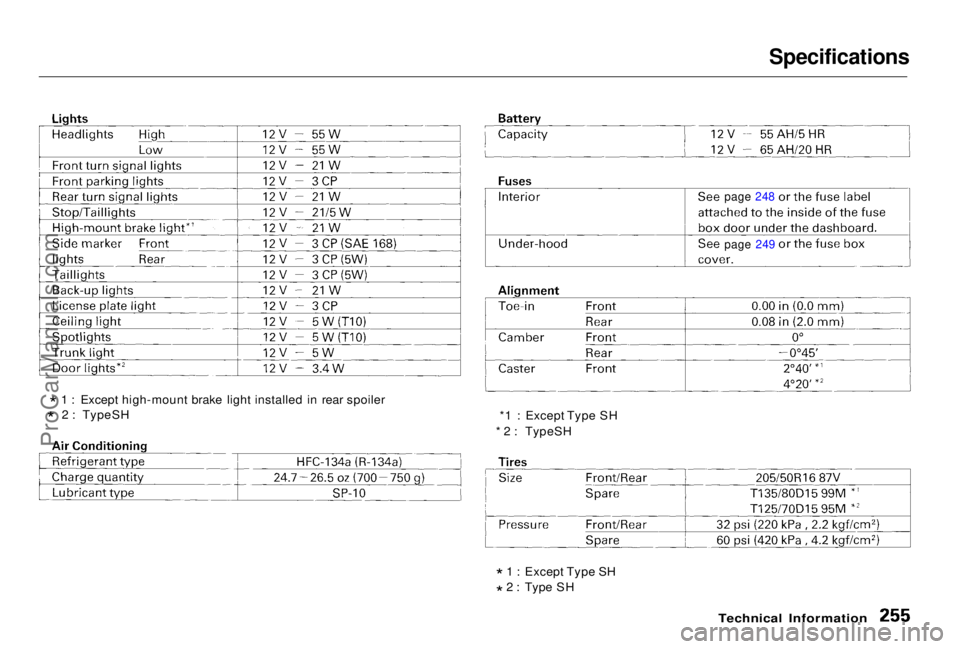
Specifications
* 1 : Except Type SH
* 2: Type SH
Technical Information
*
1 : Except high-mount brake light installed in rear spoiler
* 2 : TypeSH
*1 : Except Type SH
*2: TypeSH
page 249 page 248
ProCarManuals.comMain Menu Table of Contents s t
Page 258 of 278
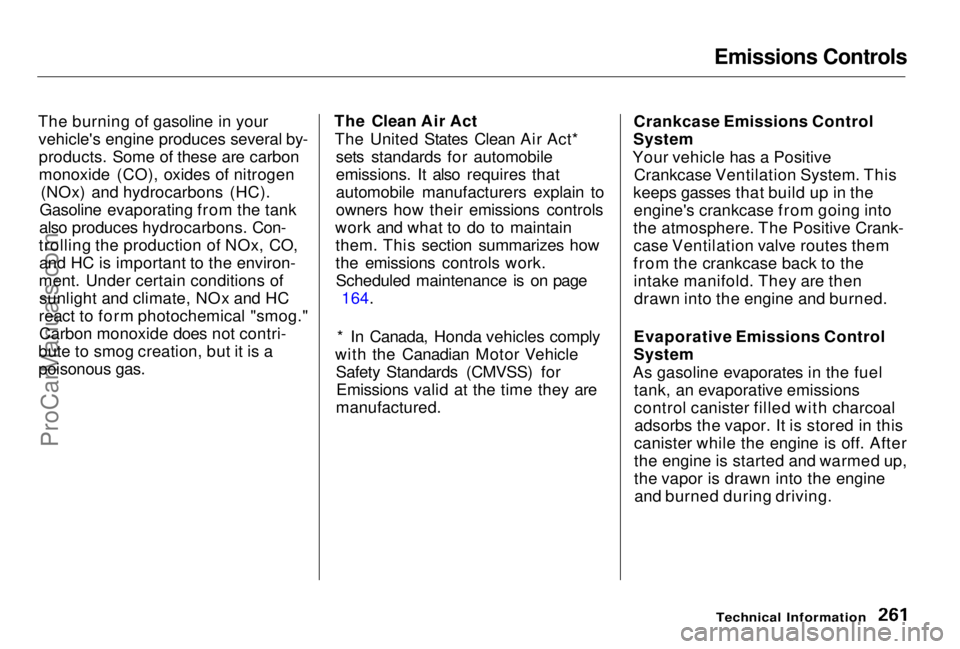
Emissions Controls
The burning of gasoline in your vehicle's engine produces several by-products. Some of these are carbon
monoxide (CO), oxides of nitrogen (NOx) and hydrocarbons (HC).
Gasoline evaporating from the tank
also produces hydrocarbons. Con-
trolling the production of NOx, CO, and HC is important to the environ-
ment. Under certain conditions of sunlight and climate, NOx and HC
react to form photochemical "smog." Carbon monoxide does not contri-
bute to smog creation, but it is a
poisonous gas. The Clean Air Act
The United States Clean Air Act* sets standards for automobile
emissions. It also requires that
automobile manufacturers explain to
owners how their emissions controls
work and what to do to maintain them. This section summarizes how
the emissions controls work.Scheduled maintenance is on page 164.
* In Canada, Honda vehicles comply
with the Canadian Motor Vehicle Safety Standards (CMVSS) forEmissions valid at the time they are
manufactured. Crankcase Emissions Control
System
Your vehicle has a Positive Crankcase Ventilation System. This
keeps gasses that build up in the engine's crankcase from going into
the atmosphere. The Positive Crank- case Ventilation valve routes them
from the crankcase back to the intake manifold. They are thendrawn into the engine and burned.
Evaporative Emissions Control
System
As gasoline evaporates in the fuel tank, an evaporative emissions
control canister filled with charcoaladsorbs the vapor. It is stored in this
canister while the engine is off. After
the engine is started and warmed up,
the vapor is drawn into the engine and burned during driving.
Technical InformationProCarManuals.comMain Menu Table of Contents s t
Page 269 of 278
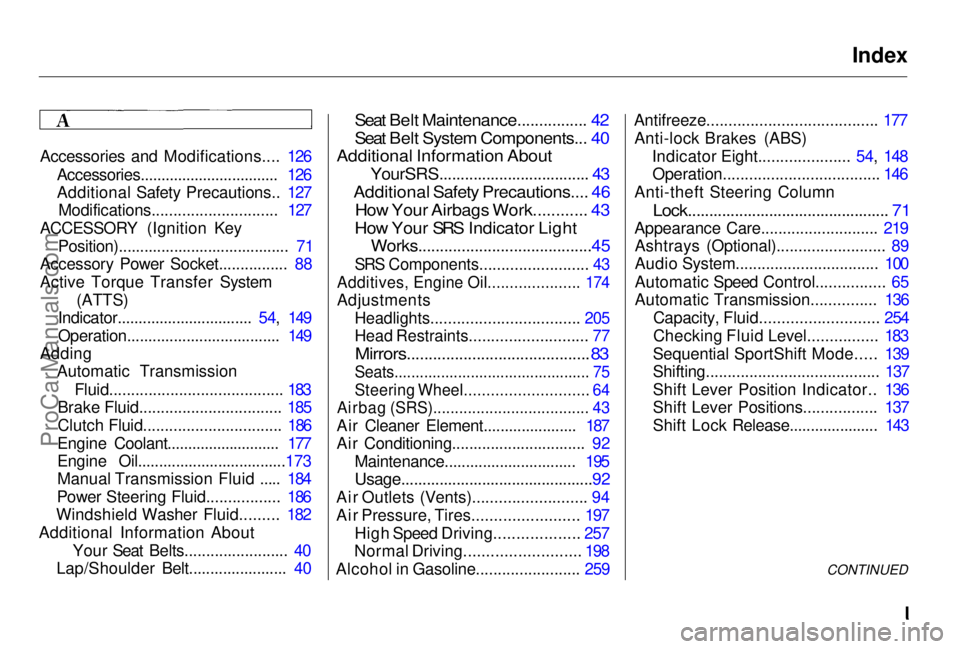
Index
Accessories and Modifications.... 126 Accessories................................. 126
Additional Safety Precautions.. 127Modifications............................. 127
ACCESSORY (Ignition Key Position)........................................ 71
Accessory Power Socket................ 88
Active Torque Transfer System
(ATTS)
Indicator................................ 54, 149
Operation.................................... 149
Adding Automatic Transmission
Fluid........................................ 183
Brake Fluid................................. 185
Clutch Fluid................................ 186
Engine Coolant........................... 177
Engine Oil...................................173
Manual Transmission Fluid ..... 184
Power Steering Fluid................. 186
Windshield Washer Fluid......... 182
Additional Information About Your Seat Belts........................ 40
Lap/Shoulder Belt....................... 40
Seat Belt Maintenance................ 42
Seat Belt System Components... 40
Additional Information About
YourSRS................................... 43
Additional Safety Precautions.... 46
How Your Airbags Work............ 43
How Your SRS Indicator Light
Works........................................45
SRS Components......................... 43
Additives, Engine Oil..................... 174
Adjustments
Headlights.................................. 205
Head Restraints........................... 77
Mirrors..........................................
83
Seats.............................................. 7 5
Steerin
g Wheel............................ 64
Airbag (SRS).................................... 43
Air Cleaner Element...................... 187
Air Conditioning............................... 92 Maintenance............................... 195
Usage.............................................92
Air Outlets (Vents).......................... 94
Air Pressure, Tires........................ 197 High Speed Driving................... 257
Normal Driving.......................... 198
Alcohol in Gasoline........................ 259 Antifreeze....................................... 177
Anti-lock Brakes (ABS) Indicator Eight..................... 54, 148Operation.................................... 146
Anti-theft Steering Column
Lock............................................... 71
Appearance Care........................... 219 Ashtrays (Optional)......................... 89
Audio System................................. 100
Automatic Speed Control................ 65
Automatic Transmission............... 136
Capacity, Fluid........................... 254
Checking Fluid Level................ 183
Sequential SportShift Mode..... 139
Shifting........................................ 137
Shift Lever Position Indicator.. 136
Shift Lever Positions................. 137
Shift Lock Release..................... 143
CONTINUEDProCarManuals.comMain Menu s t
Page 270 of 278
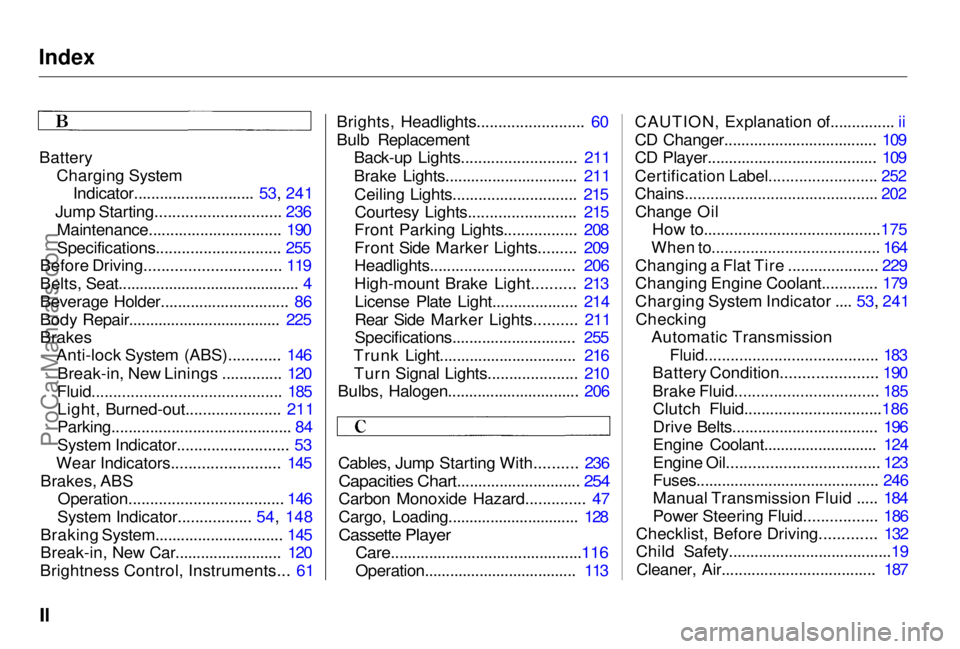
Index
Battery Charging SystemIndicator............................ 53, 241
Jump Starting............................. 236 Maintenance............................... 190
Specifications............................. 255
Before Driving............................... 119
Belts, Seat........................................... 4
Beverage Holder.............................. 86
Body Repair.................................... 225
Brakes
Anti-lock System (ABS)............ 146
Break-in, New Linings .............. 120
Fluid............................................ 185
Light, Burned-out...................... 211
Parking.......................................... 84
System Indicator.......................... 53
Wear Indicators......................... 145
Brakes, ABS Operation.................................... 146
System Indicator................. 54, 148
Braking System.............................. 145
Break-in, New Car......................... 120
Brightness Control, Instruments... 61 Brights, Headlights......................... 60
Bulb Replacement
Back-up Lights........................... 211
Brake Lights............................... 211
Ceiling Lights............................. 215Courtesy Lights......................... 215
Front Parking Lights................. 208
Front Side Marker Lights......... 209
Headlights.................................. 206
High-mount Brake Light.......... 213
License Plate Light.................... 214
Rear Side Marker Lights.......... 211
Specifications............................. 255
Trunk Light................................ 216 Turn Signal Lights..................... 210
Bulbs, Halogen............................... 206
Cables, Jump Starting With.......... 236
Capacities Chart............................. 254
Carbon Monoxide Hazard.............. 47
Cargo, Loading...............................
128
Cassette Playe r
Care.............................................
116
Operation....................................
113
CAUTION, Explanatio n
of...............
ii
CD Changer...................................
.
109
CD Player........................................ 109
Certification Label......................... 252
Chains............................................. 202
Change Oil How to.........................................175
When to....................................... 164
Changing a Flat Tire ..................... 229
Changing Engine Coolant............. 179
Charging System Indicator .... 53, 241 Checking Automatic Transmission
Fluid........................................ 183
Battery Condition...................... 190
Brake Fluid................................. 185
Clutch Fluid................................186
Drive Belts.................................. 196
Engine Coolant........................... 124
Engine Oil................................... 123
Fuses........................................... 246
Manual Transmission Fluid ..... 184
Power Steering Fluid................. 186
Checklist, Before Driving............. 132
Child Safety......................................19
Cleaner, Air.................................... 187ProCarManuals.comMain Menu s t